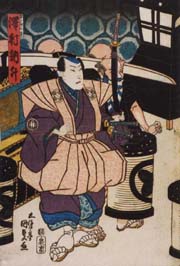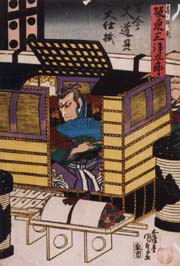| SHINMOTSU |
| Play title | Kanadehon Chűshingura |
| Common title | Shinmotsu |
| Authors | Takeda Izumo II Miyoshi Sh˘raku Namiki Senryű I |
| History |
The play "Kanadehon Chűshingura" was originally written for the puppet theater (Bunraku) and staged for the first time in the 8th lunar month of 1748 in ďsaka at the Takemotoza. It was adapted for Kabuki the same year and staged for the first time in the 12th lunar month of 1748 in ďsaka at the Kado no Shibai [casting]. The "Sandanme" act (third act) was performed with the actors Ichimura Mihoemon, Yamamoto Koheiji and Ichinokawa Hikoshir˘ II in the roles of Moron˘, Momonoi Wakasanosuke and Hen'ya Hangan. |
| Structure |
The "Sandanme" act, the third act of "Kanadehon Chűshingura", is made up of three scenes commonly called "Shinmotsu" (literally "Presenting the Bribes"), "Ninj˘" (literally "The Attack") and "Uramon" (literally "At the Back Gate"). Scene 1 and 2 are always performed for a t˘shi ky˘gen production of this drama and are never staged independently of the others acts. The "Uramon" scene, which is about the couple Kanpei/Okaru, is usually omitted (except for some t˘shi ky˘gen performances in the Kamigata style) and replaced by the michiyuki "Ochiudo". |
| Key words |
Adauchi Adauchimono Ak˘ R˘shi Chűshinguramono Gidayű Ky˘gen Giri/Ninj˘ Gishi Gishi Ky˘gen Jidaimono Seppuku Shijűshichishi Shinmotsu |
| Summary |
Previous scene: "Matsukiri" Act III, Scene 1: Shinmotsu This relatively short scene is a comedy with a sinister undercurrent. It takes place outside the rear gate of the Ashikaga mansion and introduces the obnoxious character of Sagisaka Bannai, one of Moron˘'s senior retainers. Bannai is infact one of Kabuki's greatest comic roles called d˘keyaku. In this scene, Bannai stands next to a palanquinin in which we are to suppose is Moron˘ himself, though that character never actually appears. A samurai comes to report that lord Wakasanosuke's senior retainer, Kakogawa Honz˘, is on his way here, and at this Bannai immediately assumes that he's come to continue the fight of the other day on behalf of his master. Bannai warns his lackeys that they mustn't let Honz˘ escape and that upon his signal they are to attack him. His signal will be a cough. This leads to a very funny episode in which these stupid lackeys ask for a rehearsal and repatedly get their orders wrong. At last however, Honz˘ is allowed to approach but far from wanting a fight, he has come bearing gifts which he hopes will appeal to Moron˘'s avaricious nature. Of his own accord, Honz˘ has decided to bribe the senior lord into making peace with Wakasanosuke so that any fatal confrontation will be avoided. But at first Bannai ignores him and it is only after dropping a heavy packet of coins into Bannai's sleeve that his attitude completely changes. Bannai suddenly welcomes Honz˘ warmly which throws his group of lackeys into confusion, and when he does unintentionally cough, he only manages to stop these men from attacking Honz˘ in the nick of time. Moron˘ signals to Bannai to accept the gifts after which Honz˘ is invited to join their party inside the mansion. In the final lines of the chanter, "Honz˘, sure that money would win the day, has bought the life of his master". The faithful retainer has calculated well. Courtesy of Paul M. Griffith Next scene: "Ninj˘" |
 |
 |
 |
|
The actors Sawamura Tossh˘ I, Ichikawa Danz˘ V, Ichikawa Tomoz˘ III and Band˘ Mitsugor˘ IV playing the roles of Hayano Kanpei, Kakogawa Honz˘, Sagisaka Bannai and K˘ no Moron˘ in the "Shinmotsu" scene of the third act of the classic "Kanadehon Chűshingura", which was staged in the 8th lunar month of 1835 at the Moritaza (print made by Utagawa Kunisada I) |
||
|
|
| Contact | Main | Top | Updates | Actors | Plays | Playwrights | Programs | Links | FAQ | Glossary | Chronology | Illustrations | Prints | Characters | Derivatives | Theaters | Coming soon | News |